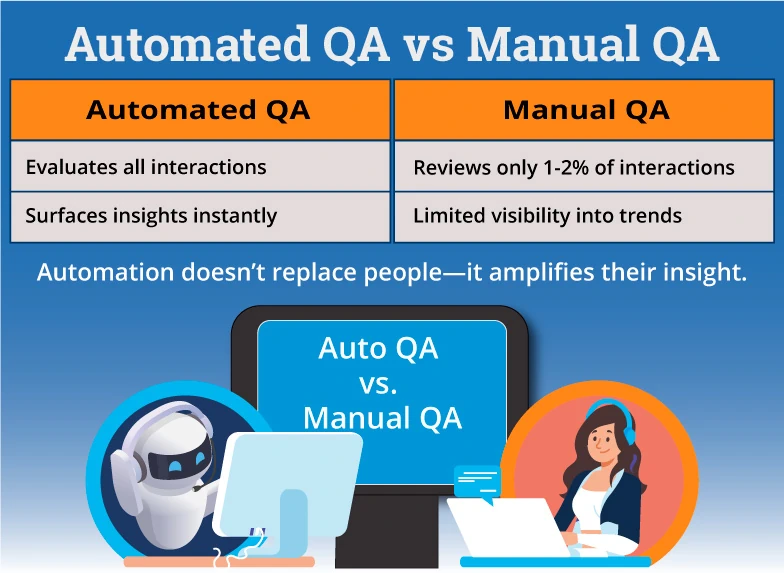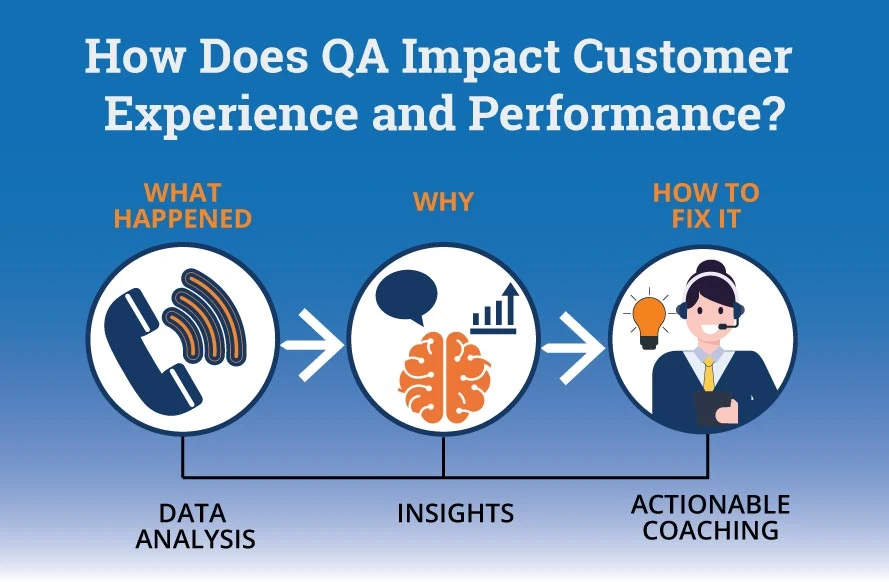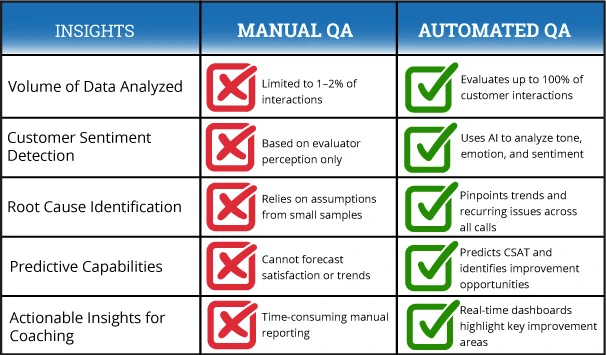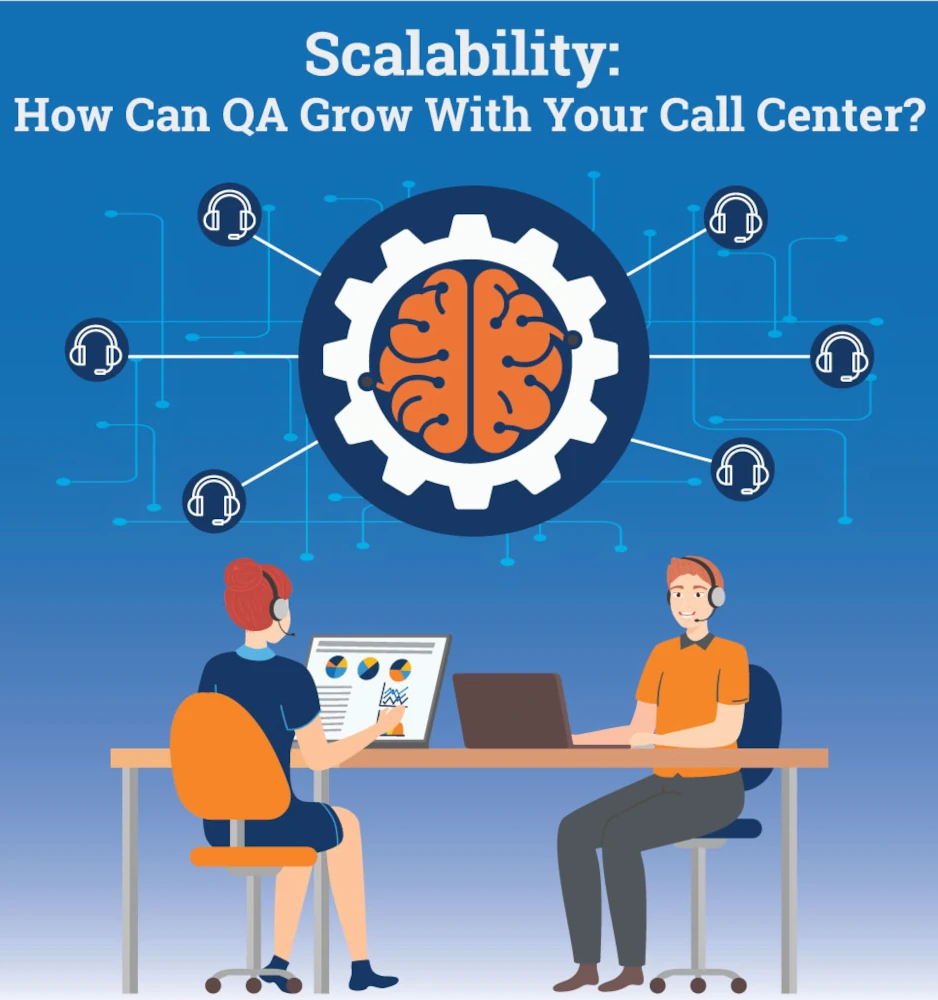Quality assurance (QA) has always been the foundation of effective call center performance. It ensures that every interaction reflects your organization’s standards for quality, accuracy, and customer care. Traditionally, QA has relied on human evaluators listening to recorded calls and scoring them based on compliance and communication skills. While valuable, this manual approach is limited in scope and efficiency as call volumes and customer expectations rise.
That’s where automated QA comes in. Powered by artificial intelligence (AI), it can evaluate thousands of interactions quickly and consistently—providing deep insights that drive improvement at scale.
At SQM Group, we help call centers bridge the gap between human judgment and AI precision. Our approach blends manual and automated QA so organizations can achieve the accuracy, scalability, and insights they need—without losing the human element that makes customer service meaningful.
Automated vs. Manual QA: What’s the Difference?
Both manual and automated QA share the same goal—improving service quality—but they approach it in very different ways.
Manual QA relies on human evaluators who listen to recorded calls or monitor live interactions to assess agent performance. It provides valuable qualitative feedback and allows evaluators to capture tone, empathy, and context. However, because it depends on human time and effort, it can only review a small portion of total interactions and may vary in consistency.
Automated QA, on the other hand, uses artificial intelligence (AI) to evaluate interactions quickly, objectively, and at scale. It identifies patterns in customer sentiment, tone, and resolution outcomes—producing data-driven insights that help call centers coach more effectively and improve the customer experience faster.
Below, we’ll explore how these two QA methods compare across key areas—coverage, impact, benchmarking, insights, accuracy, scalability, and cost—and what it means for your contact center’s future.

Coverage: What Does It Really Mean in QA?
Coverage is one of the biggest differentiators between manual and automated QA. Manual evaluation limits review capacity to about 1–2% of total interactions, meaning that the vast majority of customer conversations go unreviewed. This leaves call centers with an incomplete understanding of overall quality and performance trends.
Automated QA changes the equation entirely. By using AI to automatically assess calls, chats, or messages, automated QA can score up to 100% of interactions across multiple channels. Every agent, every customer, and every call type can be analyzed—allowing for a far more complete picture of quality and customer satisfaction.
With mySQM™ Auto QA, contact centers gain full visibility into their customer experience. The software continuously evaluates all interactions for tone, empathy, resolution, and compliance, ensuring that nothing slips through the cracks. More coverage means better insights, faster feedback, and fairer evaluations for every agent.
Impact: How Does QA Influence Customer Experience and Performance?
The purpose of QA isn’t just to measure—it’s to improve. However, traditional manual QA often focuses primarily on adherence and compliance rather than on customer experience outcomes. While this ensures procedures are followed, it doesn’t necessarily reveal how those procedures affect Customer Satisfaction (CSAT) or First Call Resolution (FCR).
Automated QA goes beyond checking boxes. It ties quality scores directly to customer sentiment and post-call survey results, creating a direct link between agent behavior and customer outcomes. AI-driven analysis can pinpoint what drives positive or negative satisfaction—whether it’s tone of voice, active listening, or issue resolution.
SQM research shows that automated QA leads to measurable improvements in both CSAT and QA scores. By surfacing actionable insights faster, supervisors can coach more effectively, and agents can make meaningful adjustments in real time. Manual QA tells you what happened; automated QA shows you why—and how to fix it.

Benchmarking: Why Does It Matter in Quality Assurance?
Another limitation of manual QA is that it’s confined within an organization’s walls. Each call center uses different evaluation standards, making it difficult to compare performance externally or identify what “good” truly looks like.
Automated QA provides a standardized framework that enables meaningful benchmarking. When data is collected and analyzed consistently across thousands of calls, QA and CSAT scores can be compared internally across teams—or externally against other organizations.
Through SQM Group’s benchmarking, call centers can evaluate performance against 500+ North American contact centers. This allows leaders to see how their service quality ranks across the industry and identify clear opportunities to close performance gaps. Benchmarking turns QA from an internal scorecard into a competitive advantage.
Insights: What Can Automated QA Reveal That Manual QA Can’t?
Manual QA provides detailed insights into a few interactions, but the small sample size makes it easy to miss recurring issues. Automated QA, by contrast, transforms QA from anecdotal to analytical by leveraging large datasets and AI-driven pattern recognition.
Automated QA uses sentiment analysis and keyword detection to reveal common customer frustrations, agent strengths, and areas for coaching. The result is a holistic view of performance trends across the entire organization, rather than isolated examples.
With mySQM™ Auto QA, organizations can combine QA data, customer feedback, and CX sentiment in one dashboard. The software’s predictive capabilities even help forecast CSAT results based on agent behavior and call patterns. Instead of reacting to survey results, call centers can take proactive steps to prevent issues and improve satisfaction before problems arise.

Accuracy: Which QA Method Delivers More Consistency?
Human evaluation adds valuable empathy and context, but it also introduces variation. Two evaluators may score the same call differently depending on personal interpretation or fatigue. Over time, this inconsistency can create frustration among agents and unreliable QA trends.
Automated QA eliminates bias by applying the same standards to every evaluation. It uses data-driven criteria to ensure each call is scored objectively and consistently. That means no favoritism, no missed details, and no fluctuating standards between evaluators.
However, the most effective approach isn’t choosing between people or technology—it’s combining them. At SQM, we recommend a hybrid model: automated QA for objectivity and scalability, and manual review for deeper coaching and context. Together, they deliver a QA process that’s both fair and human centered.
Scalability: How Can QA Grow With Your Call Center?
As call volumes increase, maintaining quality with manual QA becomes challenging. Each additional evaluator adds labor costs, training needs, and time delays in processing results. During busy seasons, QA coverage often drops, and feedback takes longer to reach agents.
Automated QA removes those limitations. Once deployed, it can instantly scale to handle more interactions without increasing staff or sacrificing speed. Whether evaluating 10,000 or 100,000 calls, AI maintains consistent scoring accuracy and turnaround time.
With mySQM™ Auto QA, contact centers can scale up or down effortlessly based on business needs. When interaction volume spikes, QA coverage remains at 100%, ensuring every customer touchpoint is evaluated—even during peak demand periods. Scalability makes automated QA not just a smarter solution but a sustainable one.

Cost: Can You Reduce QA Expenses Without Sacrificing Quality?
Manual QA is inherently labor-intensive. Each interaction requires evaluator time, limiting how many calls can be reviewed without adding staff. As teams grow, so do operational expenses.
Automated QA dramatically lowers those costs by eliminating the dependency on manual review for every call. Once implemented, it continuously evaluates interactions without increasing headcount or overtime costs. The result is broader coverage at a fraction of the cost.
SQM’s automated solution delivers significant cost reductions while maintaining or improving accuracy. The savings can then be redirected toward coaching, employee development, or other CX initiatives—creating a stronger return on investment across the organization.
Finding the Right Balance: Manual, Automated, or Hybrid
While automation offers clear advantages, many organizations benefit from a hybrid QA model that blends automation with human expertise. Automated QA handles the bulk of evaluations, ensuring objectivity and scale, while manual QA provides deeper insights into empathy, tone, and complex interactions.
A hybrid approach gives leaders flexibility. Automated tools flag calls for review, while evaluators focus their time on meaningful analysis rather than repetitive scoring. This combination strengthens QA consistency, coaching effectiveness, and overall CX quality.
SQM Group partners with contact centers to determine the right mix of automation and manual oversight. Whether through a full transition or phased adoption, our approach helps clients maximize insight, accuracy, and cost efficiency while building trust among both agents and customers.

Redefining Quality Assurance for the Future
The future of QA isn’t about choosing between people and technology—it’s about leveraging both to deliver better results. Automated QA provides the scalability, accuracy, and data depth that modern call centers need, while manual QA ensures empathy, understanding, and human connection remain central to the customer experience.
At SQM Group, we believe quality assurance should empower agents, not overwhelm them. Our mySQM™ Auto QA and manual QA solutions are designed to help organizations measure, predict, and improve every customer interaction. Whether you’re seeking cost efficiency, greater accuracy, or deeper insights, combining automation with expert analysis delivers the best path forward.
By redefining how quality assurance is done, contact centers can improve CSAT, FCR, and overall service quality—creating better experiences for both customers and agents.
